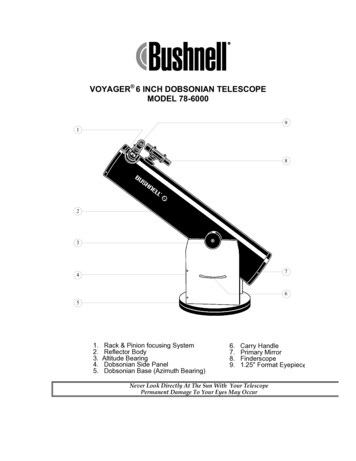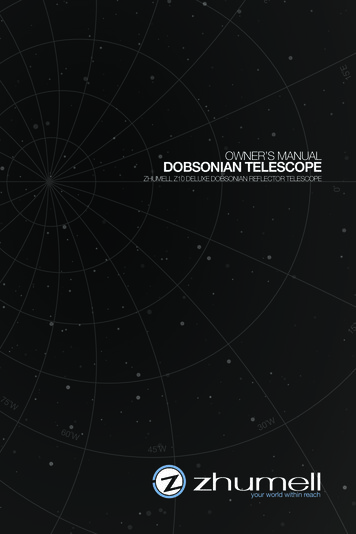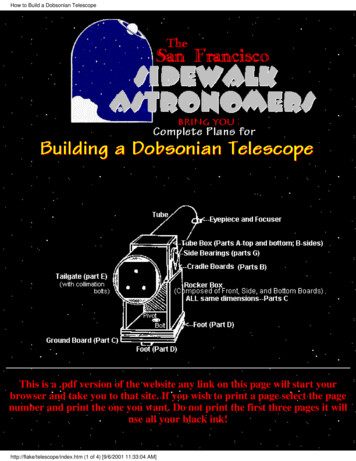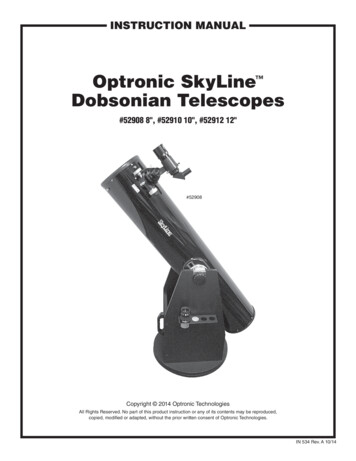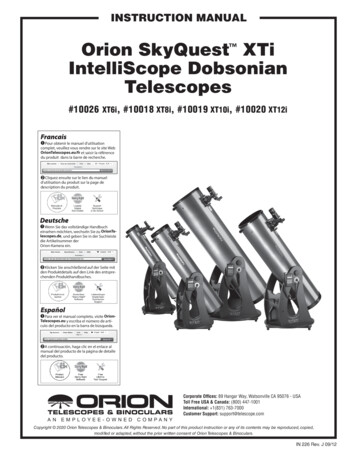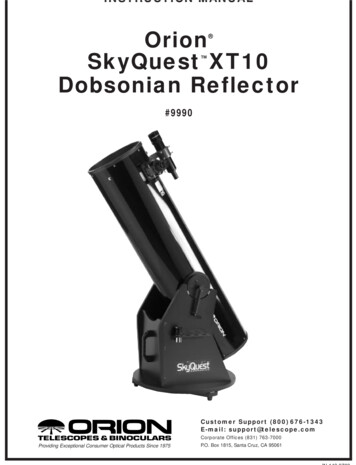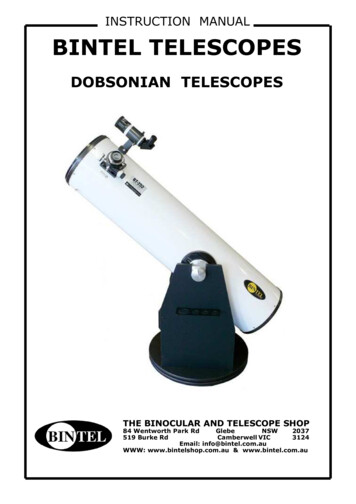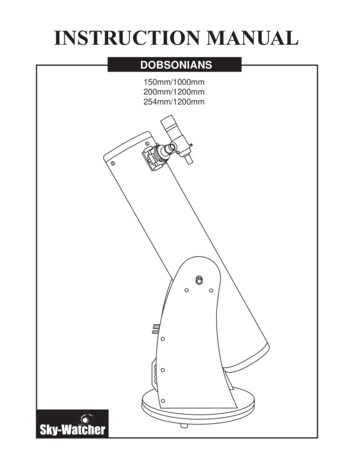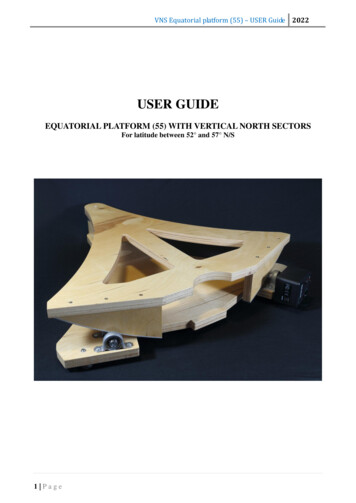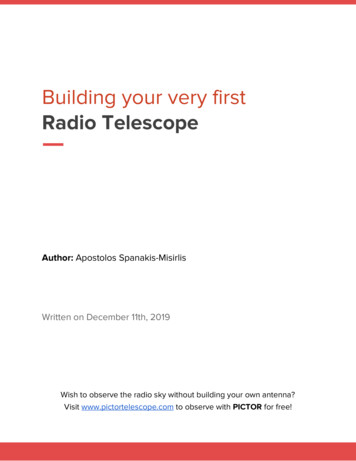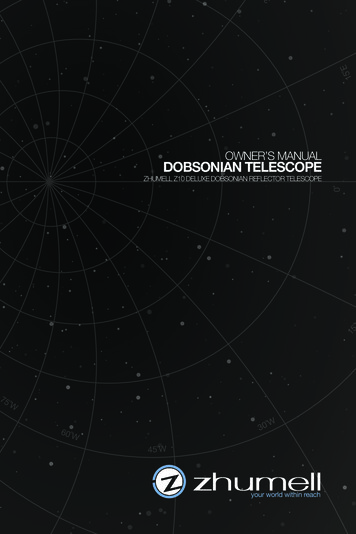
Transcription
E15 OWNER’S MANUALDOBSONIAN TELESCOPE150 ZHUMELL Z10 DELUXE DOBSONIAN REFLECTOR TELESCOPE75 WW30 60 W45 W
Zhumell customers know that there are plenty of waysto experience the world. They also understand that,however you choose to explore it, the best experience is onethat fully immerses you in the world’s most striking details.That’s where our optics products come in. We strive to puthigh-performance products in the hands of our customersso that they can experience the world up close, with theirown eyes.With Zhumell, you get field-tested, precision-crafted optics atthe best possible value. So even if you’re just starting out asan amateur birder or astronomer, you don’t have to settle forentry-level products. Zhumell customers enjoy life’s pursuits,hobbies, and adventures in rich, colorful detail- the kind ofdetail that only high-performance optics can produce.At Zhumell, we design our binoculars, telescopes, andspotting scopes for discerning, price-conscious userswho are uncompromising on quality. If you’re looking foraccessibly priced optics that will bring your world withinreach, you’re looking for Zhumell.Enjoy the dob.2
ENJOYING YOURZHUMELL DOBSONIAN TELESCOPE1. Caring For Your Telescopei. Warningsii. Cleaning and Maintenanceiii. Collimation2. Specifications3. Parts List4. Telescope Assemblyi. Base Assemblyii. Optical Tube Assembly5. Donsonian Telescope Basicsi. 1.25-inch Eyepiecesii. 2-inch Eyepiecesiii. Altitude and Azimuthiv. Focusing the Imagev. Cooling Fanvi. Transportation6.Viewing Through Your Telescopei. Checking and Aligning Your Finderscope7.Observation Tipsi.ii.iii.iv.v.vi.Selecting a Viewing SiteCooling Your TelescopeSeeing and TransparencyDark-AdaptingTracking Celestial ObjectsSelecting an Eyepiece8. Cool Viewsi. The Moonii. The Planetsiii. The Starsiv. Deep-Sky Objectsv. Starhopping9. Astronomy Formulas10. Astronomy Terminology11. Telescope Terminology12. FAQs13. Warranty3
CARING FOR YOURZHUMELL DOBSONIAN TELESCOPEZhumell telescopes are precision astronomical instrumentsdesigned for ease of use and versatility in their application. Aswith any telescope, Zhumell telescopes require some technicalknowledge of stellar movement and optical properties. We haveprovided basic instructions for telescope use and astronomicalviewing in this manual.Your Zhumell Dobsonian telescope is built with the highest-qualityoptics and top-notch construction to provide years of reliablefunctionality, but will require proper care.If, after reading this manual, you still have questions about yourZhumell telescope, please visit http://www.zhumell.com formore helpful tips and contact information. Our customer servicerepresentatives are available to address any problems youencounter with your telescope. Please let us know about yourexperiences; we would like to hear your feedback.Enjoy your Zhumell.4
CARING FOR YOURZHUMELL DOBSONIAN TELESCOPEWARNINGS Do not use telescope or finderscope to look at the sun withoutan appropriate solar filter. Doing so will cause permanent andirreversible eye damage. Never use an eyepiece filter as a solar filter. Only solar filters willcompletely cover the opening of the optical tube and provideproper eye protection. Make sure no screws are loose before using telescope. Do not drop or shake your telescope as doing so may damagethe optics, or harm you or the people around you.5
USING YOURZHUMELL DOBSONIAN TELESCOPECOLLIMATIONPeriodically, you will find that it is necessary to align the optical componentsof your telescope. This procedure is called collimation. There is nocollimator included with the Zhumell Dobsonian, but regular collimation isrecommended for optimum telescope usage.1. Remove the eyepiece from the eyepiece holder and insert lasercollimator into eyepiece holder. Secure the laser collimator by tighteningthumbscrew.2. Turn the thumbscrew located on the side of the collimator to turn onthe collimator.3. Look through the hole in the side of collimator to see where the laser isreflected onto the reticle. If you cannot see the laser reflected back ontothe reticle, align the secondary mirror by adjusting the secondary mirrorcollimation screws until the laser is reflected onto the inside ofthe collimator.4. Loosen 3 locking screws on bottom of optical tube (the thin ones thatstick farther out from the back of the mirror).5. Align the laser to the center of the reticle by adjusting the 3 primarymirror adjustment screws (the thick screws in the back of the mirror). Donot over-turn these screws (max of ¼ turn at a time).6. Tighten the 3 locking screws on bottom of optical tube to lock theprimary mirror into place.6
USING YOURZHUMELL DOBSONIAN TELESCOPECLEANING AND MAINTENANCEA telescope is carefully aligned during construction, and great care shouldbe taken to maintain this alignment over the life of the telescope. Cleaningshould be done as little as possible and then only with mild soap solutionand a soft, lint-free cloth. Do not rub elements when cleaning. Blot opticalcomponents gently and allow telescope to air-dry. Store telescope in its boxor in a telescope case when not in use. Do not use pure alcohol or solventsto clean any parts of the telescope. Do not remove optical elements from thetelescope as doing so may affect the alignment of optical components whenreassembled. If telescope needs realignment, contact Zhumell or anotherprofessional.1. Brush telescope optics with camelhair brush or blow off dust with an earsyringe (can be purchased at any pharmacy). Do not use a commercialphotographic lens cleaner.2. Remove organic materials (e.g. fingerprints) with short gentle strokes usingsoft white tissue paper and a solution of three parts distilled water andone part isopropyl alcohol. You may also add one drop of biodegradabledish soap to one pint of the homemade solution. Do not use lotioned orscented tissues as they could damage the optics of your telescope.3. Wipe down the outside of your telescope with a dry cloth to removecondensation prior to packing up your telescope. Do not wipe any of theoptical surfaces. Instead, allow the optics to dry naturally in warm indoorair prior to packing up your telescope.4. Protect your telescope from excessive heat. For example, do notstore your telescope in a sealed car on a warm day. Excessive storagetemperatures can damage your telescope.7
SPECIFICATIONS FOR YOURZHUMELL DOBSONIAN TELESCOPEOPTICAL TUBE ASSEMBLYZhumell Z10Objective/Aperture254 mm / 10 inchesFocal Length1250 mmLimiting Magnitude14.52Focal RatioF/4.92Eyepiece Format: 1.25 inch, and 2 inchFinderscope: 8x50Mount Type: DobsonianTube Mount: Cradle MountMount Adjustment: Altitude-AzimuthMaterials: Wood, MelaminePARTS LISTBox 1 of 2 Dobsonian optical tubePlastic tube cover2 silver side bearingsCooling fan, attached at bottom of opticaltubeBattery pack for cooling fanNewtonian collimator30 mm eyepiece (2 inch format)9 mm eyepiece (1.25 inch format)Moon filter (1.25 inch format)Box 2 of 2 8x50 finderscopeHandle10 long black Allen screws2 medium silver Allen screws 3 medium silver Phillips screwsAllen wrench3 black plastic feet2 short black Phillips screwsEyepiece holder shelf2 large round black wood base platesLazy susan (2 metal discs with a blackplastic roller in the middle)One black knob, with a thick screw, spacer,large washer, small ball bearing washer, andsmall plain washer2 large black wood side panels for the base1 small black wood side panel for the baseNot Included Philips ScrewdriverAA BatteriesAll Holes have been predrilled8
ASSEMBLY OF YOURZHUMELL DOBSONIAN TELESCOPEUnbox and gather the pieces for base assembly. You will need:a.b.c.d.e.f. Eyepiece Tray (and (2) blackBase Sides (2)Base FrontBase Plates (2)Bearing Plates (3)Handle (and (2) silverAllen screws)g.h.i.j.Philips screws)Feet (3)Long Black Allen Screws (10)Allen WrenchAdjustment Bolt (with (2)washers, (1) ball bearing, and(1) Axle Sleeve)bdcaegfhj
ASSEMBLY OF YOURZHUMELL DOBSONIAN TELESCOPE1BASE ASSEMBLYFirst, you will be assembling the telescope base housing. This will be the structure that holds yourscope in place.STEP 1: Screw the handle onto the Base Front using the (2) pre-drilled holes on thefront. Make sure that it is secure.STEP 2: Connect the Base Front to the Left Base Side using the pre-drilled holes in the Base Front and(2) Long Black Allen ScrewsSTEP 3: Repeat with the Right Base Side to complete the box. Be sure that all three sides are firmlyattached and feel stable.10
ASSEMBLY OF YOURZHUMELL DOBSONIAN TELESCOPESTEP 4: To attach the Eyepiece Tray to the Right Base, it’s easiest to turn the assembly on its side. Attachthe tray using the (2) pre-drilled holes and (2) black Philips screws. Return the base to standing position andmake sure the tray is secure.YOU ARE NOW READY TO BEGIN THE ASSEMBLY OF THE BASE PLATE. THIS WILL BE THE PART THATALLOWS YOUR BASE HOUSING AND TELESCOPE TO ROTATE IN A “LAZY SUSAN” STYLE.STEP 5: First, the feet must be attached to the Base Plate. Choose the Base Plate with (1) center hole and(3) holes around the edge. IMPORTANT: The feet must be attached to the side with a brass center hole.Screw all (3) feet in place, with the wider side facing the board, using (3) medium silver Philips screws.STEP 6: Choose the Base Plate with (1) center hole and (6) holes around the edge. Flip the base housingupside-down and align the six pre-drilled holes with the base plate.11
ASSEMBLY OF YOURZHUMELL DOBSONIAN TELESCOPESTEP 7: Be sure the side with recessed holes is facing away from the base housing. Screw (6) long blackAllen screws into these holes until they are flush with the surface.STEP 8: To assemble the Adjustment Bolt, hold the parts in your hand in this order: Small Washer; BallBearing; Large Washer. Place them on the threaded bolt in that order, with the small washer closest to theplastic knob.STEP 9: Place the Base Plate with feet on level ground, feet facing downward. Insert the Axle Sleeve intothe center hole.12
ASSEMBLY OF YOURZHUMELL DOBSONIAN TELESCOPESTEP 10: Arrange the Bearing Plates with the “wagon wheel” plate sandwiched between the two light blue plates.Place this whole assembly onto the Axle Sleeve centered on the Base Plate. Check that it rotates smoothly.STEP 11: Pick up the Base Plate and Base Housing assembly and place it on top of the Base Plate and BearingPlate Assembly, aligning the center hole with the Axle Sleeve. The top assembly should now rotate freely over thebottom Base Plate.STEP 12: Screw the Adjustment Bolt (with washers and ball bearing) into the Axle Sleeve, through all of theassembled base parts. This will be your means to rotate and secure your Dobsonian.13
ASSEMBLY OF YOURZHUMELL DOBSONIAN TELESCOPE2OPTICAL TUBE ASSEMBLYUnbox and gather the pieces for the Optical Tube Assembly. These are -abdfca.b.c.d.Dobsonian Optical TubeFinderscopeSilver Side Bearings (2)Laser Collimatoree.f.g.h.ghBattery Pack for Cooling Fan1.25-inch 9mm Plossl Eyepiece2-inch 30mm Plossl Eyepiece1.25-inch Moon Filter.STEP 1: Remove the (2) bolts found on the opening on one side of the OTA. This is where you willconnect the silver Side Bearing. Align the bearing (top bolt first) and tighten into place. Repeat on the otherside of the OTA.14
ASSEMBLY OF YOURZHUMELL DOBSONIAN TELESCOPESTEP 1: Remove the (2) bolts found on the opening on one side of the OTA. This is where you willconnect the silver Side Bearing. Align the bearing (top bolt first) and tighten into place. Repeat on the otherside of the OTA.STEP 2: You are now ready to place the OTA onto the Base Assembly. Be sure to have the baseassembly ready to align with the OTA before you lift the optical tube. The indentations on the BaseAssembly will perfectly fit the silver Side Bearings on the OTA.STEP 3: Locate the Finderscope Bracket on the OTA. Loosen the thumbscrew on the bracket with yourfingers and slide the Finderscope into place. Tighten the screw so that the Finderscope is secure.You are now ready to insert an eyepiece and begin using your Zhumell Dobsoniantelescope. Continue reading for instructions and viewing tips.15
BASICS FOR YOURZHUMELL DOBSONIAN TELESCOPEUSING 1.25-INCH EYEPIECES1. The 1.25-inch is the most commonly used eyepiece format. Themeasurement of 1.25 inches is the diameter of the eyepiece tube,measured on the chrome side.2. The eyepiece holder and Crayford focuser come already attached to theoptical tube, next to where the finderscope is mounted.3. Remove the plastic dust cover from the eyepiece holder.4. Loosen the silver thumbscrew closest to the eyepiece hole. (It is part ofthe 1.25-inch adapter. More on this adapter in the Z- incheyepiece section.)5. Take out your 1.25-inch eyepiece. Remove the plastic covers and pullup the rubber to use the eyecup.6. Slide the chrome end of the eyepiece into the eyepiece holder.7. View through the eyepiece and focus as needed. (See focusing section.)8. To remove the eyepiece, loosen the silver thumbscrew.9. Pull out the eyepiece from the holder.10. Use the plastic dust covers to protect the eyepiece and focuserduring storage.16
BASICS FOR YOURZHUMELL DOBSONIAN TELESCOPEUSING 2-INCH EYEPIECES1. The 2-inch eyepiece format is the largest. 2 inches is the diameter of theeyepiece tube, measured on the chrome side.2. Loosen the silver thumb screw underneath the eyepiece opening.3. Pull the adapter out of the focuser.4. Take out your 2-inch eyepiece. Remove the plastic covers.5. Slide the chrome end of the eyepiece into the focuser.6. Tighten the bottom thumbscrew to hold eyepiece in place.7. View and focus as desired.8. To remove, loosen the thumbscrew and pull the eyepiece out of the focuser.9. For storage, replace the adapter with the dust cover.17
BASICS FOR YOURZHUMELL DOBSONIAN TELESCOPEALTITUDE AND AZIMUTH1. Your Zhumell Dobsonian is adjustable along two axes - altitude (up/down) and azimuth (left/right). Adjustments to the telescope’s positioncan be made along one or both axes at the same time.2. Gently take hold of the end of the OTA and move it either left or right (itwill spin about its central azimuth bolt) or up and down (it will rotate onthe Side Bearings on the OTA).3. The telescope can be positioned to view anywhere in the night sky, butbe sure to let it move naturally - never force your telescope to move.FOCUSING THE IMAGE1. With an eyepiece in the focuser, loosen both back thumbscrews on theleft side on focuser.2. Push or pull the focuser gently until image becomes as clear as possible.3. Alternatively, turn the large, up-down, rack-and-pinion knobs to adjustthe focus. The black knob will adjust in smaller increments than thelarge silver knobs.4. The back thumbscrew will completely lock the focus. The frontthumbscrew will lock the push/pull ability, so that only the rack-andpinion knobs can be used to adjust focus.5. Tighten both knobs to completely lock the focuser.18
BASICS FOR YOURZHUMELL DOBSONIAN TELESCOPECOOLING FAN OPERATION(10- and 12-inch models only)1. Insert 8 AA batteries into the battery adapter.2. Locate the cooling fan at the bottom of the OTA.3. Plug in the battery adapter to the telescope - cooling fan will begin running.4. When you are finished using the telescope, unplug the battery adapter,take out batteries, and store.TRANSPORTATION1. IMPORTANT - never try and transport both the base and OTA as asingle unit. Gently lift the OTA off the base and secure in a telescopecase for transportation. Move the base separately, as a single unit,and handle with care.2. If you do not have a case for your Dobsonian, let common sensedictate your transportation storage. It is vital that the OTA does notroll or move around at all during travel, as this will affect the telescopealignment. Pad and secure your telescope accordingly.19
VIEWING THROUGH YOURZHUMELL DOBSONIAN TELESCOPENever look at the sun without using a solar filter. Do not use a regulareyepiece as a solar filter. When using a solar filter, do not remove thefull lenscap, view only through the small opening. Looking at the sunwithout proper use of a solar filter can cause permanent eye damage,included blindness.When viewing through the telescope, the image will appear to beupside-down and inverted. This is normal and is a result of the opticalsystem design. It can be corrected by using an erecting prism whenviewing, but it is not necessary to do so.Using your finderscope will help you locate celestial much morequickly as the finderscope is equipped with a wider field of view thanyour telescope. To simplify focusing while viewing, start with the lowestpower magnification and work up to the desired power.When viewing faint deep-sky objects, images will not show color. Thehuman eye is not able to distinguish the differences in color found insuch dim images. The lack of color is due to human anatomy, not anylimitations of telescope construction.20
VIEWING THROUGH YOURZHUMELL DOBSONIAN TELESCOPECHECKING AND ALIGNING YOUR FINDERSCOPEFinderscope alignment is the first step to fine-tuning your ZhumellDobsonian setup and viewing celestial objects. Follow these steps toproperly set up and align your finderscope.1. Insert the lowest-power eyepiece into the eyepiece adapter. Focuseyepiece to view an easily recognizable, stationary distant object like asign or lightpole.2. Look through the finderscope, but be careful not to move thetelescope in any way. Adjust the finderscope focus by turning theeyepiece of the finderscope back and forth until the image is in focus.Check to see if the object viewed through your telescope eyepieceis lined up at the center of the finderscope crosshairs. If not, yourfinderscope must be re-aligned.3. To align your finderscope, slightly loosen the thumbscrews whichon the finderscope bracket. Gently move the finderscope until thecrosshairs are centered on your object. Tighten the thumbscrews tosecure the finderscope in this position. It may take many tries to get itexactly right, but it will make finding objects much, much easier whenyou’re ready to use your telescope.OBSERVATION TIPSSELECTING A VIEWING SITEThe ideal site for using your Dobsonian is in the middle of nowhere. Mostusers don’t have access to the darkest of skies, however, so select asite that is both far from light pollution and practical for you. Avoid streetlights, yard lighting, rooftops, and chimneys, and never observe throughan open window indoors. Be sure your site is out-of-town or very darkand has clear view of a large portion of the sky.21
OBSERVATION TIPS FOR YOURZHUMELL DOBSONIAN TELESCOPECOOLING YOUR TELESCOPETo achieve optimum stability of its lenses and mirrors, yourtelescope needs to reach “thermal equilibrium” before use.When moved to a warmer or colder environment, the air insidethe telescope needs time to adjust to match the outdoortemperature. The bigger the telescope, the more time will beneeded to reach equilibrium.Dobsonian telescopes are some of the largest available, soyou will need to allow at least 30 minutes for yours to reachthermal equilibrium. If the scope experiences more than a40 temperature change, allow at least an hour. In the coldermonths, storing your telescope in a shed or garage greatlyreduces the time needed for equilibrium. Similarly, keepingyour telescope covered in the sun prevents the air inside fromwarming too drastically.Your Zhumell Dobsonian comes with a cooling fan to helpspeed up the process of reaching thermal equilibrium. Whenplugged into the scope, it will bring in outside air and reducethe time you need to wait.SEEING AND TRANSPARENCYAtmospheric conditions are of the utmost importance when considering viewing conditions for your astronomical binoculars. Theseconditions are commonly referred to as “seeing.” When seeing isgood, star twinkling is minimal and objects appear steady in yourlenses. Seeing is best overhead, worst at the horizon, and generallybetter after midnight. You can’t see the stars without looking throughthe atmosphere, so the clearer the air and the higher your altitude,the better seeing conditions you will encounter.22
OBSERVATION TIPS FOR YOURZHUMELL DOBSONIAN TELESCOPEA reliably quick way to judge seeing conditions is to look at brightstars about 40 above the horizon. If the stars appear to twinkle,there is significant atmospheric distortion and viewing at high magnification will not be ideal. If these stars are steadily bright, chances ofsuccessful viewing at high magnification are much better.Judging the transparency of the air is also important in determiningviewing conditions. The best air is free of moisture, dust, and smoke,which tend to scatter light, reducing a viewed object’s brightness.How many stars can you see with your naked eye? If you are unableto see stars of magnitude 3.5 or dimmer, transparency in your areais poor. A good indicator star for this test is Megrez (mag. 3.4) - thestar in the Big Dipper connecting the handle to the dipper. If Megrezis not visible, elements in the air will negatively affect your view.DARK-ADAPTING YOUR EYESWhen you go out into the dark, your eyes need time to adjust. Youwill initially be able to see only a fraction of the stars and objectsyour eyes are capable of.Remain in the dark (don’t look at any lights or cell phones) for atleast 30 minutes, and your eyes should be around 80% of their fulldark-adapted sensitivity. Every time bright light comes into your eye,the dark-adapting process will start over.When eyes are fully dark-adapted, you will probably still need to seewhat you’re doing. Use a red-light flashlight to maneuver aroundthe area. A regular flashlight covered in red cellophane will work, butred LED lights are best.23
OBSERVATION TIPS FOR YOURZHUMELL DOBSONIAN TELESCOPETRACKING CELESTIAL OBJECTSThe Earth is always rotating about its polar axis, completing one fullrotation every 24 hours. This is what defines our “day”, and we seeit in the apparent movement of sun and stars throughout each rotation. In the same way that the sun rises and sets each day, the starsin the sky rise and set each night. The motion translates to a rate ofapproximately .25 per minute, or 15 arc-seconds per second. Thisis commonly referred to as the sidereal rate.As you observe any celestial object, remember that it is in motion.You will need to continuously update your telescope’s positionthroughout a viewing session, which is where your Dobsonian’s finealtitude and azimuth adjustments become useful. As an object begins to leave your field of view, gently nudge the OTA in the correctdirection and bring it back to center.Remember, the higher the magnification at which you’re viewing, thesmaller your field of view. Objects will appear to move faster as youraise magnification, and more frequent positional adjustments willneed to be made.SELECTING AN EYEPIECEBy using eyepieces of different focal lengths, many different magnifications can be achieved with your Zhumell Dobsonian telescope.The best place to start is with the included 9mm and 32mm Plossleyepieces for higher and lower magnifications, respectively. Manyastronomers own a large number of eyepieces in order to customizetheir equipment based on the object being viewed. To calculate themagnification of a telescope/eyepiece combination, divide the focallength of the telescope by the focal length of the eyepiece.24
OBSERVATION TIPS FOR YOURZHUMELL DOBSONIAN TELESCOPENo matter which eyepiece you intend to use, always start by using thelowest-power (longest focal length) eyepiece to locate and center theobject. Lower magnification means a wider field of view, making it easierto find an object and justify your scope in its direction.Once you’ve centered the desired object using your lowest-powereyepiece, go ahead and make the switch to a higher magnification. Makefurther centering adjustments, and continue to work up if desired. Highermagnifications are useful for small and bright objects like planets anddouble stars. Viewing the Moon with increased magnification also yieldsgreat results.Deep-sky objects, however, typically look best at medium and low magnifications. This is because they tend to be faint, yet have apparent width.Deep-sky objects often fall from view at higher magnifications, since theimage becomes dimmer. This is not an unbreakable rule, since manygalaxies are bright enough for high magnification, but words as a decentrule-of-thumb.Regardless of the object, or what recommendations are made, the bestway to become familiar with proper viewing magnifications is to experiment. Always start with low magnification and wide field-of-view and workyour way up. If the view continues to improve, continue increasing power.If the image begins to degrade, back off the magnification and use alower-power eyepiece.25
COOL VIEWS WITH YOURZHUMELL ASTRONOMICAL BINOCULARSTHE MOONThe Earth’s moon is one of the easiest and most rewarding targetsat which to point your binoculars. Its rocky, cratered surface is closeenough to be rendered in some detail, and allows for satisfyingexploration. The best time for lunar viewing is during its partial phases,when shadows fall on the craters and canyon walls to give themdefinition. Even though the full moon may look like a tempting target,the light is too bright and the definition too low for optimal viewing.THE STARSThrough your binoculars, stars will appear much as they do to thenaked eye - as tiny points of light against a dark sky. Even powerfulbinoculars cannot magnify stars to appear as anything more thanthese pinpoints. You can, however, enjoy the different colors of theirglow and locate many beautiful double- and multiple-stars. Twopopular targets are the “Double-Double” in the constellation Lyra andthe two-color double star Albireo in Cygnus.THE PLANETSThe planets are beautiful and popular targets for astronomers, but theycan be more difficult to keep track of than the stars or moon. Planetaryposition charts can readily be found online or in any astronomicalpublication. Sun and Moon aside, the brightest objects in the nightsky are Venus, Mars, Jupiter, and Saturn. The apparent size of planetscan be quite small, but high-power binoculars provide an adequatelyenjoyable view.26
ADVANCED OBSERVATIONJUPITERJupiter is our solar system’s largest planet. Through your binocs, youcan easily see the planet and observe the changing positions of itsfour largest moons: Io, Callisto, Europa, and Ganymede. With the rightconditions, you may be able to see cloud bands wrapped around theplanet and the famous Great Red Spot.SATURNThis infamously ringed planet can be a fantastic sight through yourbinoculars. The tilt-angle of the rings varies over a period of manyyears, so they may be seen edge-on (like a thin line) or broadside (likegiant “ears” on each side of the planet). You will need a good steadyatmosphere to achieve a worthwhile view of Saturn. If you look closelyenough, you can see the Cassini division - a thin, dark gap in the rings.You can also often make out one or more of Saturns moons, includingthe largest - Titan.VENUSAt its brightest, Venus is the most luminous of all the planets - so brightthat it is occasionally visible in full daylight. Venus appears as only athin crescent at its brightest, and it is never found far from morningor evening horizon. No surface detail can be seen on Venus as it issurrounded by dense cloud cover.MARSMars makes a close approach to our planet once every two years,which is the best time to observe it. With your binoculars, you’ll be ableto see a salmon-colored disk marked with dark patches and possible awhitish polar ice cap. Surface detail on Mars is only observable duringprime conditions with a high-power magnification.27
ADVANCED OBSERVATIONDEEP-SKY OBJECTSWith dark skies, ideal viewing conditions, and powerful astronomicalbinoculars, you can observe a number of amazing objects outside oursolar system - commonly referred to as “deep-sky objects”. Theseinclude star clusters, galaxies, gaseous nebulas, and more. Withprimary conditions, your binoculars are well equipped to gather the lightnecessary to view these objects, but you will need to find a viewing sitewell away from light pollution and give your eyes plenty of time to fullydark-adapt. As you continue to view, your eyes will become trained, andmore and more subtle details from these objects will become apparent.Don’t expect to see color, however, as human eyes are not sensitiveenough to distinguish color from faint light.STARHOPPINGStarhopping is the most common and simplest way to reliably trackdown objects in the night sky. It uses relative positioning, beginning ata star with a known location and progressing to other stars closer andcloser to the destination object. It’s been used for hundreds of years,and - with practice - will never let you down when finding an object.Starhopping can be very difficult at first, so be patient and keep trying!You will need a small number of additional resources to successfullyemploy Starhopping as your night-sky positioning technique. A starchart or atlas that shows stars to at least magnitude 5 is required.Choose one that shows the positions of many deep-sky objects to giveyourself a wealth of options. If you don’t already know the positions ofthe constellations in the night sky, you will need a planisphere as well.28
ADVANCED OBSERVATIONBegin by choosing brighter deep-sky objects as your destination.The brightness of an object is measured by its visual magnitude;the brighter an object, the lower its magnitude. Choose an objectwith a visual magnitude of 9 or lower. Most beginners start withthe Messier objects, some of the brightest and most beautifuldeep-sky objects, first catalogued about 200 years ago by Frenchastronomer Charles Messier.Using your star chart, determine in which constellation yourobject lies and locate that constellation in the night sky. Turn yourbinoculars to face this general direction. Find the brightest star inthis co
ZHUMELL Z10 DELUXE DOBSONIAN REFLECTOR TELESCOPE. 2. Zhumell customers know that there are plenty of ways . to experience the world. They also understand that, however you choose to explore it, the best experience is one that fully immerses you in the world's most striking details.
